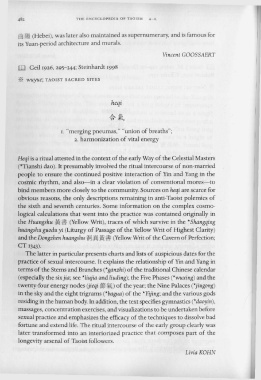Page 522 - The Encyclopedia of Taoism v1_A-L
P. 522
T H E ENCYCLOPED IA OF TAOISM A - L
ftlJ ~Jd (Hebei), was later also maintained as supernumerary, and is famous for
its Yuan-period architecture and murals.
Vincent GOOSSAERT
III Geil 1926, 295- 344; Steinhardt 1998
* wuyue; TAOIST SACRED SITES
heqi
I. "merging pneumas," "union of breaths";
2. harmonization of vital energy
Heqi is a ritual attested in the context of the early Way of the Celestial Masters
(*Tianshi dao). It presumably involved the ritual intercourse of non-married
people to ensure the continued positive interaction of Yin and Yang in the
cosmic rhythm, and also-in a clear violation of conventional mores-to
bind members more closely to the community. Sources on heqi are scarce for
obvious reasons, the only descriptions remaining in anti-Taoist polemics of
the sixth and seventh centuries. Some information on the complex cosmo-
logical calculations that went into the practice was contained originally in
the Huangshu jitif (Yellow Writ), traces of which survive in the *Shangqing
huangshu guodu yi (Liturgy of Passage of the Yellow Writ of Highest Clarity)
and the Dongzhen huangshu WiJ ~ ~ if (Yellow Writ of the Cavern of Perfection;
CT 1343).
The latter in particular presents charts and lists of auspicious dates for the
practice of sexual intercourse. It explains the relationship of Ym and Yang in
terms of the Stems and Branches (*ganzhi) of the traditional Chinese calendar
(especially the sixjia; see *liujia and liuding); the Five Phases (*wuxing) and the
twenty-four energy nodes (jieqi fli'i~) of the year; the ine Palaces (*jiugong)
in the sky and the eight trigrams (*bagua) of the *Yijing; and the various gods
residing in the human body. In addition, the text specifies gymnastics (*daoyin),
massages, concentration exercises, and visualizations to be undertaken before
sexual practice and emphasizes the efficacy of the techniques to dissolve bad
fortune and extend life. The ritual intercourse of the early group clearly was
later transformed into an interiorized practice that composes part of the
longevity arsenal of Taoist followers.
LiviaKOHN

